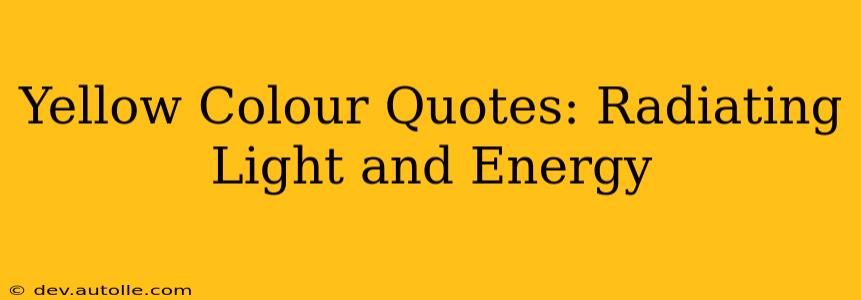Yellow. The color of sunshine, optimism, and intellectual curiosity. It's a vibrant hue that evokes a range of emotions, from joyful exuberance to cautious warning. Throughout history and across cultures, yellow has been imbued with symbolic meaning, finding its way into art, literature, and even everyday conversations. This exploration delves into the fascinating world of yellow, examining its symbolism and presenting a collection of captivating quotes that capture its essence.
What does the color yellow symbolize?
Yellow's symbolism is rich and multifaceted. Often associated with happiness, joy, and optimism, it can also represent intelligence, creativity, and energy. However, it's important to note that the connotations of yellow can vary across different cultures and contexts. In some cultures, yellow symbolizes betrayal or cowardice, while in others, it represents royalty or spirituality. The intensity and shade of yellow also play a significant role in shaping its interpretation. A bright, sunny yellow evokes feelings of warmth and cheerfulness, whereas a duller, mustard yellow might suggest caution or decay.
What are some famous quotes about the color yellow?
While there isn't a vast corpus of literature dedicated solely to the color yellow in the way there might be for, say, red or blue, its presence is felt subtly yet powerfully in many famous works. The feeling evoked by yellow is often described indirectly, through imagery and metaphor. Let's explore some quotes that touch upon the essence of yellow:
"The sun is a yellow star." - (A simple, factual observation, yet it encapsulates the primary association of yellow with the sun and its warmth)
This seemingly simple statement highlights the inherent connection between the color yellow and the sun, a connection deeply ingrained in our collective consciousness. The sun, the source of life and energy, is often associated with positivity and warmth, qualities directly linked to the color yellow.
"But I have promises to keep, And miles to go before I sleep, And miles to go before I sleep." - Robert Frost, Stopping by Woods on a Snowy Evening
While not explicitly mentioning yellow, the image of a snowy evening evokes a sense of coldness and stillness, often contrasted with warmer, brighter colors like yellow. The speaker's journey continues despite the cold, suggesting a resilience and determination, a sense of moving towards a brighter, possibly "yellow," future.
"If you are born with yellow hair you will be golden, if you have curly hair and your father makes a fortune, you will be a big wig." – Yiddish proverb
This proverb showcases the cultural association of yellow hair with status and prosperity. "Golden" is used metaphorically to represent wealth and success, highlighting the positive connotations yellow can hold within specific cultural contexts.
What are the different shades of yellow and their meanings?
The richness of yellow lies not just in its brightness, but in its many shades. Each shade carries its own nuanced meaning:
- Golden Yellow: Represents wealth, success, and royalty. It evokes feelings of luxury and prestige.
- Lemon Yellow: Light and airy, this shade represents freshness, energy, and optimism. It often conveys a sense of zest and vibrancy.
- Mustard Yellow: A darker, earthier shade that can symbolize caution, intelligence, and wisdom. It can also represent a sense of the old and established.
- Pale Yellow: Suggests gentleness, serenity, and calmness. It is often associated with innocence and purity.
How is yellow used in art and design?
Yellow is a powerful tool in art and design. Artists utilize its luminosity and vibrancy to create striking visuals, evoke emotions, and guide the viewer's eye. From the radiant sunflowers of Van Gogh to the bold color blocks of modern art, yellow consistently commands attention and adds depth to any composition. Its use in design can range from cheerful and playful to sophisticated and elegant, depending on its context and the other colors it's paired with.
What are the psychological effects of yellow?
Studies have shown that yellow can have a significant impact on our psychology. It's a stimulating color that can increase alertness, creativity, and mental acuity. However, excessive exposure to bright yellow can also lead to feelings of anxiety or irritability. Therefore, the use of yellow in environments should be carefully considered to optimize its positive effects while minimizing potential negative ones.
In conclusion, yellow is more than just a color; it's a powerful symbol carrying a wealth of cultural and emotional significance. Its vibrant energy and multifaceted symbolism continue to inspire artists, writers, and designers, solidifying its place as one of the most captivating colors in the spectrum.

